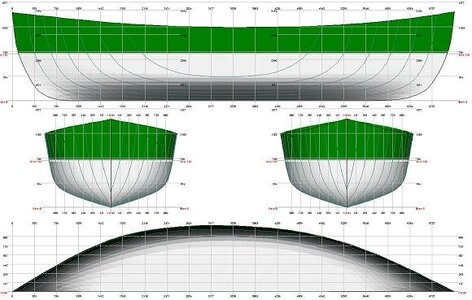Very good looking model - Great appearance
-

Win a Free Custom Engraved Brass Coin!!!
As a way to introduce our brass coins to the community, we will raffle off a free coin during the month of August. Follow link ABOVE for instructions for entering.
-

PRE-ORDER SHIPS IN SCALE TODAY!
The beloved Ships in Scale Magazine is back and charting a new course for 2026!
Discover new skills, new techniques, and new inspirations in every issue.
NOTE THAT OUR FIRST ISSUE WILL BE JAN/FEB 2026
You are using an out of date browser. It may not display this or other websites correctly.
You should upgrade or use an alternative browser.
You should upgrade or use an alternative browser.
I have also been working on a case for my James Caird model. After cutting and assembling the pieces, I decided to make the base of a case into a snowfield, on which the model will sit. I accomplished this by roughing up the base with my power carving tools, creating subtle hills and valleys, and then painting the base to resemble snow. A coat of gesso was followed by several coats of white and a wash of dilute cerulean blue to create the illusion of shadows on the snow. I even carved into the base the two tracks that would have resulted from the sledge being dragged across the surface.
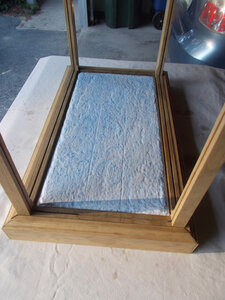
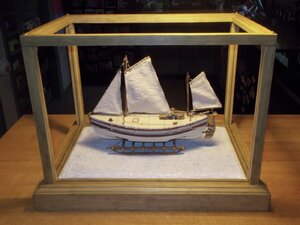


Thats a great effort. Well done.
A very unique and realistic model.
Beautiful work sir.
Beautiful work sir.
Your research and dedication to scale accuracy in the build is excellent and well presented with the explanations that will provide suggestions to other modelers facing some of the same tasks. Well done. . . no. . . OUTSTANDING. PT-2Nice build Jonrton and have to agree with you Ted
Thanks for all the kind words. I do not have the technical skills that many modelers have, but I always try to have my models tell a story in some way. Is there such a thing as “narrative shipmodeling”?
In some ways, I think every ship model can be considered a 'narrative' - the actual (fullsize) boats/ships each had a history - some were undistinguished, but others played a major role in events.Thanks for all the kind words. I do not have the technical skills that many modelers have, but I always try to have my models tell a story in some way. Is there such a thing as “narrative shipmodeling”?
For example, my 'King's Fisher' was a British sloop that got tangled up in the American war of Independence, while 'Natterer' was modelled on a Lake Windermere (UK) steam launch that featured in the invention of the 'Kitchin' rudder, and in early experiments with Radio Control.
In addition, a model can be depicted in an appropriate setting, as is your James Caird, or maybe on the slip being built or repaired - they are all 'narratives'.
You appear to have a very interesting model collection - you should show us some more!
Ted
I have seen some beautifully made ship models at shows, nicely displayed in cases and with labels with the name of the ship, the scale, and the model builder. For a model builder, these models are a source of inspiration and motivation, as well as information on how to create this or that detail. For the general public, however, the history behind the ship or boat is often not described at all or might be on a small plaque or card. I have seen people walking through ship model shows taking only cursory glances at some really gorgeous models. I want to include something on each of my models that would catch the attention the non-modeler walking by the display, causing that person to stop and wonder what the model is really all about. For this model, the “bait” will be a figure of a pensive Shackleton standing on the ice next to the boat, contemplating it and touching it with his hand, as if he is questioning whether the makeshift craft that he and his carpenter have put together will actually carry him the 800 or so miles to South Georgia. Each of our models has a story and represents a conscious choice by us to invest scores or hundreds of hours of work in creating it. We should all attempt to communicate that story, or that history, through our design and presentation of our models, in my opinion. That’s my story and I’m sticking to it.
I have already posted pictures of several of my models in the “completed models” forum. Hope you enjoy them.In some ways, I think every ship model can be considered a 'narrative' - the actual (fullsize) boats/ships each had a history - some were undistinguished, but others played a major role in events.
For example, my 'King's Fisher' was a British sloop that got tangled up in the American war of Independence, while 'Natterer' was modelled on a Lake Windermere (UK) steam launch that featured in the invention of the 'Kitchin' rudder, and in early experiments with Radio Control.
In addition, a model can be depicted in an appropriate setting, as is your James Caird, or maybe on the slip being built or repaired - they are all 'narratives'.
You appear to have a very interesting model collection - you should show us some more!
Ted
Last edited:
Some additional photos of the James Caird, outside of its case. I am starting work on two figures, one of Shackleton and one of a crew member working inside the boat. Shackleton will be standing on the snow alongside the boat, with one hand touching the side of the Caird as if to say “I really hope you can carry us on this impossible voyage to South Georgia”! I will make the figures from epoxy clay over wire armatures, and will post in-progress photos of the process I use.
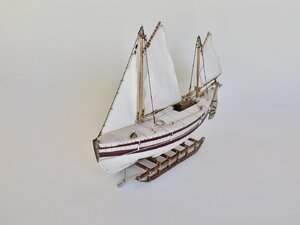
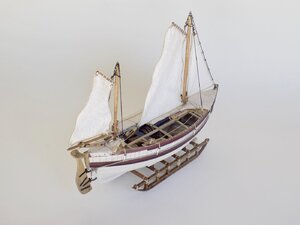


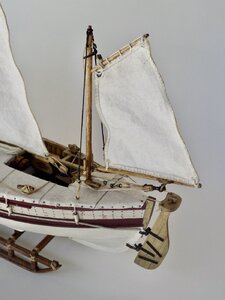
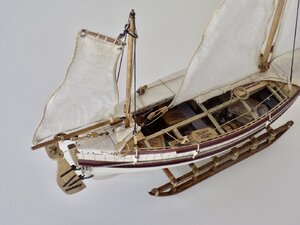
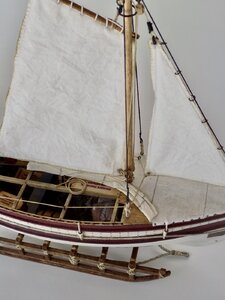
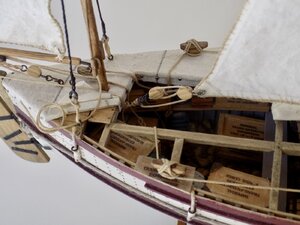








Hallo @JnortonSome of the SoS members have suggested that I create a blog for my latest model, the James Caird. I am well into the work on this model, but can provide some information and images of its early stages so that readers of this blog can see what I have done so far. I am building the model with the modifications created by the carpenter Henry "Chippy" McNeish while the Endurance crew was trapped on the ice as well as the final modifications made by McNeish in Elephant Island prior to the 800 nautical mile voyage to South Georgia Island (yet to come).
The initial modifications made to the James Caird by McNeish while on the ice included raising the gunwale of the double-ended whaler carried by the Endurance by almost two feet by the addition of three additional planks, using wood from the ruined Endurance and one of the other lifeboats, and the construction of "whalebacks" at the bow and stern. The latter would greatly reduce the amount of water that would splash into the boat in heavy waves.
The final modifications made on Elephant Island included building a lattice-like framework over the open boat using sled runners, installing a flimsy deck over these supports using the lids of plywood packing cases, and covering the whole topsides with a canvas covering stitched together from sections of sail. A 5' by 2.5' "cockpit" was left open just in front of the mizzen mast so that the crew could work the halyards, sheets, and rudder.
There was some damage to the hull because of the hauling of the boats across the ice on sledges and because of collisions with ice floes during the 9-day trip taken by the three remaining boats from the edge of the melting ice to Elephant Island. The damage was repaired by McNeish on Elephant Island in a variety of ways, one of which involved creating patches using the Muntz metal flotation tanks originally installed on the Caird when it was built as a lifeboat. The remarkable work by McNeish to transform the boat for its open sea journey was accomplished using only a hammer, a saw, a chisel, and an adze.
I intend to make the model represent the boat just before its launching, with all of the above modifications including the stone ballast, supplies, sleeping bags, brass patches, and figures of Shackleton and some of the Endurance crew.
I want this model to tell the incredible story of the preparations for Shackleton's incredible 16-day voyage across the South Atlantic, in winter, from one speck of land - Elephant Island - to another - South Georgia. This model certainly fits with my plan to model small open boats that have made historic voyages.
Hope you enjoy the postings that will appear below. As I stated above, the first few will be historical, that is, they will show work I have done on the model to date. Once I am caght up with that, I will start posting my progress in "real time".
we wish you all the BEST and a HAPPY BIRTHDAY

Signing off for this build log, thanks for the nice comments, all.
Fantastic subject and fantastic build, lovey work Jnorton.
Cheers,
Stephen.
Cheers,
Stephen.
It has been a while since I built the model. I will have to look through my records to see if I can locate the lines for the Caird that I got from a member of the Model Ship World forum, who used photogrammetry to create CAD lines from old photographs of the James Caird.
Have you done any more work on this model?
Pointer121, the model is done and is displayed in the home of Son #1. I visit it whenever I can!







